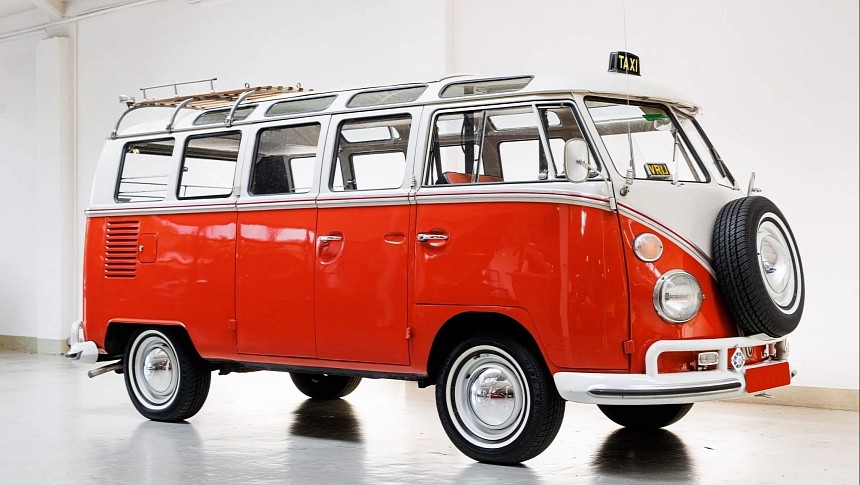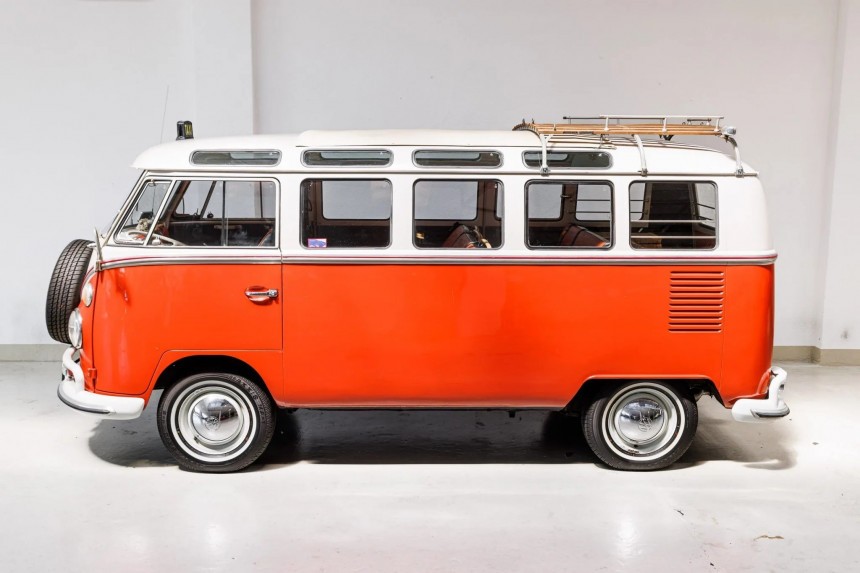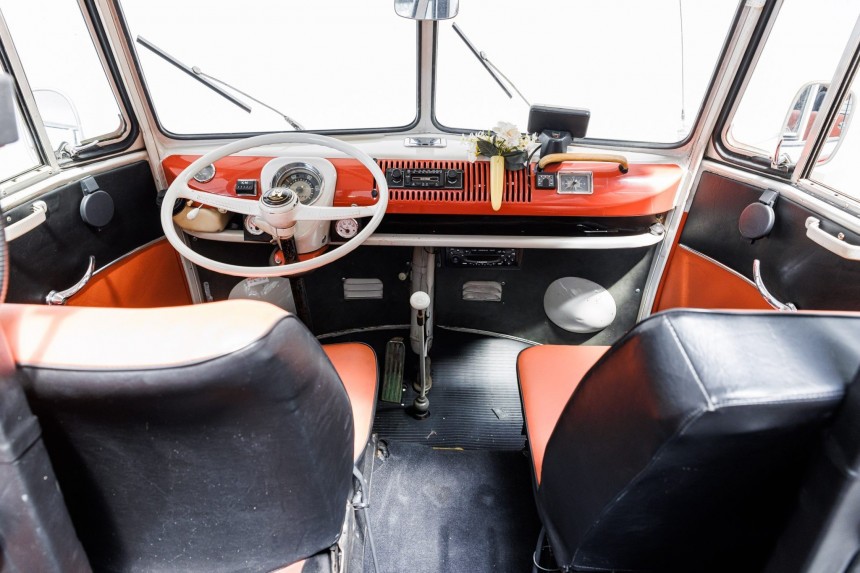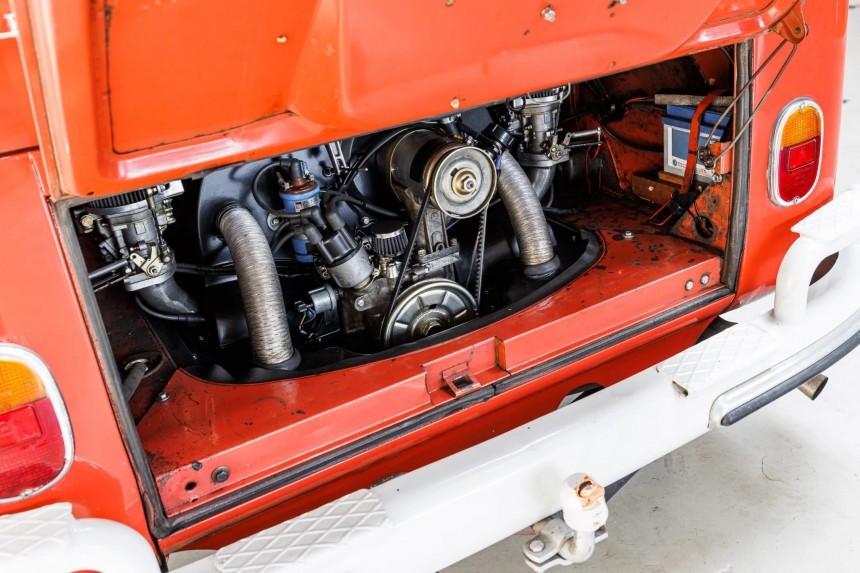It's finally summer. I can't wait to finish my exams and head to the beach. But what should I drive there? There are many options for what I could use to go there, but one rises above all. I am, of course, talking about the cute VW Bus. So, to celebrate summer, let's look at this 21-window sunroof deluxe taxi from 1965.
Before looking at this beautiful Bus, we should have a quick history lesson about how this bubble on wheels came to be and what that exceptionally long name means. The Volkswagen Type 2, known as the Bus, was born in 1949, thanks to a Dutch VW importer, Ben Pon. The story goes that he visited a Volkswagen factory, where he saw the utility vehicles used to transport parts around, and a lightbulb lit up over his head.
So, with fire in his eyes, he got to the drawing board, designing a sketch for a bare-bones utilitarian vehicle. He presented said sketch to the Volkswagen board, and everyone liked it, so they gave the green light to make it, and the prototype was created. Upon testing the prototype, known as the Type 29, in a wind tunnel, engineers created two of the most notable characteristics of the Bus - the split windshield and a V-shaped roofline.
The Bus is as big as a modern Golf, yet incredibly roomy inside. This is so thanks to another revolutionary addition - the cab-over design, with the engine in the back. That makes for lots and lots of room inside.
The cute Busses started to roll off the assembly line in 1950, and you could opt for three different configurations. The first one is the Combi, which, as the name suggests, combines a passenger vehicle and a cargo one. It had only two rear windows and removable rear seats so that you could haul a lot of stuff.
But, if you have even more stuff to move around, there is the Transporter, a van-only iteration of the Bus. After the sales started to pick up, Volkswagen introduced a more luxurious version of the Bus, called the Microbus, and then an even fancier one, known as the Samba. The Samba came with two different configurations - a 21 or a 23-window layout.
But, at first, there was a problem - the Bus was criminally slow. The air-cooled 1.1-liter (67 ci) flat-four installed produced only 25 hp (25.3 ps), which meant a top speed of 55 mph (90 kph) - it sometimes feels I can go faster on my bicycle. But, over the years, the first generation got more ponies under the hood, so all was right with the world.
And the VW Bus quickly caught on, mainly in the hippie landscape. What's there not to like? The happy-go-lucky looks, reliability, and ease of repair made up the perfect candidate for traveling to the beach and other, say smoky activities. And honestly, I fantasize about heading to the beach in one of these things, and upon laying eyes on the one we have here today, that desire only got more powerful - so let's waste no more time and take a look.
I'll start with the appearance, the main concern about these cars. The cutie-tootsie looks are amplified by the two-tone paint, with a popping orange on the bottom and a glowing white for the top part, both of which were refinished under previous ownership. The white theme continues to the bumpers and tires with a thin white stripe on the side. Speaking of the tires, they are wrapped around 14-inch steel wheels that proudly display polished hubcaps with the VW logo on them.
A sliding white fabric roof ties off the outside to let all that sun and beach air in. In front of it, you'll find a small but exciting thing - a taxi sign. Yes, this Bus was born and first used as a taxi in Germany before relocating to the Netherlands. So, what does that taxi sign mean for the Bus? Well, for this particular one, actually nothing. It was just used as a taxi, but it was an ordinary Bus. But you could also get one in the Lotação configuration, made by the VW factory in Brazil. It had SIX front-hinged doors and four bench seats - there were so many vans, man.
Moving on to the inside, an orange-and-white color scheme is also the norm. The front bucket seats and the full-width rear benches are upholstered in orange vinyl with black accents, which are also present throughout the cabin on rubber floor mats and door cards. The white makes its presence known on the headliner, which is also perforated, part of the dashboard, and the steering wheel. The steering wheel has a two-spoke design with a gold Wolfsburg crest in the middle. It fronts a big 120 kph (75 mph) speedometer alongside regular gauges, like fuel and oil.
Popping open the hood will reveal a furious flat-four churning out a whopping 50 hp (51 ps). Kidding aside, the VW Bus was still slow even after the abovementioned improvements. You get on the road, put on music, and move along at a steady 55 mph (90 kph), and that is it. You will shove it in top gear of the four-speed manual transaxle and enjoy the road.
In the States, the T1 was a hit, but the T2 never got a chance - why, you may ask? Well, because of the Chicken Tax. I know, it's as ridiculous as it sounds. The chicken tax was an extra tariff from France and Germany on American chicken produce. Thus, in retaliation, America placed a 25% import tax on European potato starch, dextrin, brandy, and for god-knows-what reason - light trucks, a category under which you can find the VW Bus. The T2 is great, and you can find them out there if you look hard enough, but honestly, in my eyes, they don't stand a chance in front of the T1.
If you have the same perspective as me and want a T1 really bad, this one is up at auction in Naarden, Netherlands. It currently sits at only 7,700 dollars, but there are six whole days left on the auction, and judging by their history, the price will skyrocket. It comes with a service booklet and Dutch registration documents. I will have to pass on this one because, you know, money, and I will take my Dacia to the beach this summer. But I genuinely believe you should buy one if you can.
So, with fire in his eyes, he got to the drawing board, designing a sketch for a bare-bones utilitarian vehicle. He presented said sketch to the Volkswagen board, and everyone liked it, so they gave the green light to make it, and the prototype was created. Upon testing the prototype, known as the Type 29, in a wind tunnel, engineers created two of the most notable characteristics of the Bus - the split windshield and a V-shaped roofline.
The Bus is as big as a modern Golf, yet incredibly roomy inside. This is so thanks to another revolutionary addition - the cab-over design, with the engine in the back. That makes for lots and lots of room inside.
But, if you have even more stuff to move around, there is the Transporter, a van-only iteration of the Bus. After the sales started to pick up, Volkswagen introduced a more luxurious version of the Bus, called the Microbus, and then an even fancier one, known as the Samba. The Samba came with two different configurations - a 21 or a 23-window layout.
But, at first, there was a problem - the Bus was criminally slow. The air-cooled 1.1-liter (67 ci) flat-four installed produced only 25 hp (25.3 ps), which meant a top speed of 55 mph (90 kph) - it sometimes feels I can go faster on my bicycle. But, over the years, the first generation got more ponies under the hood, so all was right with the world.
I'll start with the appearance, the main concern about these cars. The cutie-tootsie looks are amplified by the two-tone paint, with a popping orange on the bottom and a glowing white for the top part, both of which were refinished under previous ownership. The white theme continues to the bumpers and tires with a thin white stripe on the side. Speaking of the tires, they are wrapped around 14-inch steel wheels that proudly display polished hubcaps with the VW logo on them.
A sliding white fabric roof ties off the outside to let all that sun and beach air in. In front of it, you'll find a small but exciting thing - a taxi sign. Yes, this Bus was born and first used as a taxi in Germany before relocating to the Netherlands. So, what does that taxi sign mean for the Bus? Well, for this particular one, actually nothing. It was just used as a taxi, but it was an ordinary Bus. But you could also get one in the Lotação configuration, made by the VW factory in Brazil. It had SIX front-hinged doors and four bench seats - there were so many vans, man.
Popping open the hood will reveal a furious flat-four churning out a whopping 50 hp (51 ps). Kidding aside, the VW Bus was still slow even after the abovementioned improvements. You get on the road, put on music, and move along at a steady 55 mph (90 kph), and that is it. You will shove it in top gear of the four-speed manual transaxle and enjoy the road.
In the States, the T1 was a hit, but the T2 never got a chance - why, you may ask? Well, because of the Chicken Tax. I know, it's as ridiculous as it sounds. The chicken tax was an extra tariff from France and Germany on American chicken produce. Thus, in retaliation, America placed a 25% import tax on European potato starch, dextrin, brandy, and for god-knows-what reason - light trucks, a category under which you can find the VW Bus. The T2 is great, and you can find them out there if you look hard enough, but honestly, in my eyes, they don't stand a chance in front of the T1.
If you have the same perspective as me and want a T1 really bad, this one is up at auction in Naarden, Netherlands. It currently sits at only 7,700 dollars, but there are six whole days left on the auction, and judging by their history, the price will skyrocket. It comes with a service booklet and Dutch registration documents. I will have to pass on this one because, you know, money, and I will take my Dacia to the beach this summer. But I genuinely believe you should buy one if you can.















